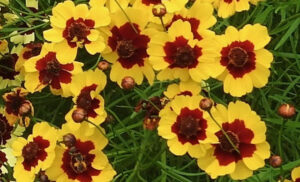Crazy for Coreopsis
by Tammany Baumgarten

Native gardeners are crazy for Coreopsis! There are 13 species of Coreopsis, pronounced “core-ee-OP-siss,” that are native to Louisiana and all are long-blooming, sturdy, good wildlife plants that add weeks of color to our Louisiana gardens starting very early in the Spring. Some Coreopsis are annuals that live and die in one season while others are perennial and can last for many years. One common name for Coreopsis is Tickseed, which may refer to the dark, shiny seeds of some of them or the potential for the seeds to stick to skin or clothing. Indeed, it is very easy to collect seed from these plants and easy to grow them, making them a perfect plant to share and popular in wildflower and pollinator mixes.
Coreopsis is a favorite of the horticulture industry and while lots of breeding work has produced many named selections and cultivars of this plant, there are several straight species that are adaptable, beautiful plants for a sunny, well-drained garden. Sometimes, in breeding efforts to make a plant more appealing to people, wildlife benefits can be compromised, making plants less useful to insects, bees and birds. Using straight species, just as they occur in the wild, ensures that your plants will have all of the natural wildlife benefits that nature intended.
Two of the more common species of Coreopsis used in gardens are C. lanceolata and C. tinctoria. Coreopsis lanceolata, Lance-leaf Coreopsis, is perennial and has large, pure golden yellow flowers. It grows about 12-16” tall and is an early bloomer, beginning in late March and going through June. Like most of our Coreopsis, it prefers well-drained sunny spaces and happily re-seeds, sometimes creating large colonies. In early April, Lance-leaf Coreopsis in combination with other Coreopsis species like C. pubescens and C. intermedia can be seen in late Spring and early summer on Louisiana roadsides in the piney regions of the state.
 Coreopsis tinctoria, also known as Plains Coreopsis, is an annual species, lasting only one season, and can be seen growing wild on disturbed roadside areas, but is also a gardener’s favorite. These fast-growing plants can be direct seeded into garden beds and pots or planted out as plants. They always reward with a multitude of bi-colored flowers with yellow petals, red-brown at the base and brown center discs. The flowers are carried above airy, finely cut foliage on tall plants at 2-4 feet. They respond very well to pinching or cutting back when young to produce a denser, more branched plant. There are variations of C. tinctoria that present very pale yellow, ivory or mahogany red petals. Again, C. tinctoria prefers well drained and full-sun situations and can handle poorer soils. It is easy to collect seed or just allow this plant to re-seed itself in the garden.
Coreopsis tinctoria, also known as Plains Coreopsis, is an annual species, lasting only one season, and can be seen growing wild on disturbed roadside areas, but is also a gardener’s favorite. These fast-growing plants can be direct seeded into garden beds and pots or planted out as plants. They always reward with a multitude of bi-colored flowers with yellow petals, red-brown at the base and brown center discs. The flowers are carried above airy, finely cut foliage on tall plants at 2-4 feet. They respond very well to pinching or cutting back when young to produce a denser, more branched plant. There are variations of C. tinctoria that present very pale yellow, ivory or mahogany red petals. Again, C. tinctoria prefers well drained and full-sun situations and can handle poorer soils. It is easy to collect seed or just allow this plant to re-seed itself in the garden.
Coreopsis are the perfect plants for wildflower gardens, meadows, pollinator gardens, naturalistic and native plantings. A combination of species will provide weeks of color early in the growing season. They do fine in poorer soils, and tolerate our heat and humidity well if given a well-drained situation. Many species of pollinators, especially native bees, will use Coreopsis and at least two moths use it as a host plant. In addition, the seeds may also be eaten by birds. Native gardeners are crazy for Coreopsis and it’s easy to see why!
The Native Plant Initiative of Greater New Orleans is hosting two Crazy for Coreopsis native plant giveaways in the GNO area, February 20th and 27th. Each family will receive one or more FREE native Coreopsis plants as supplies last. Go to npi-gno.org for locations, times and other details.
